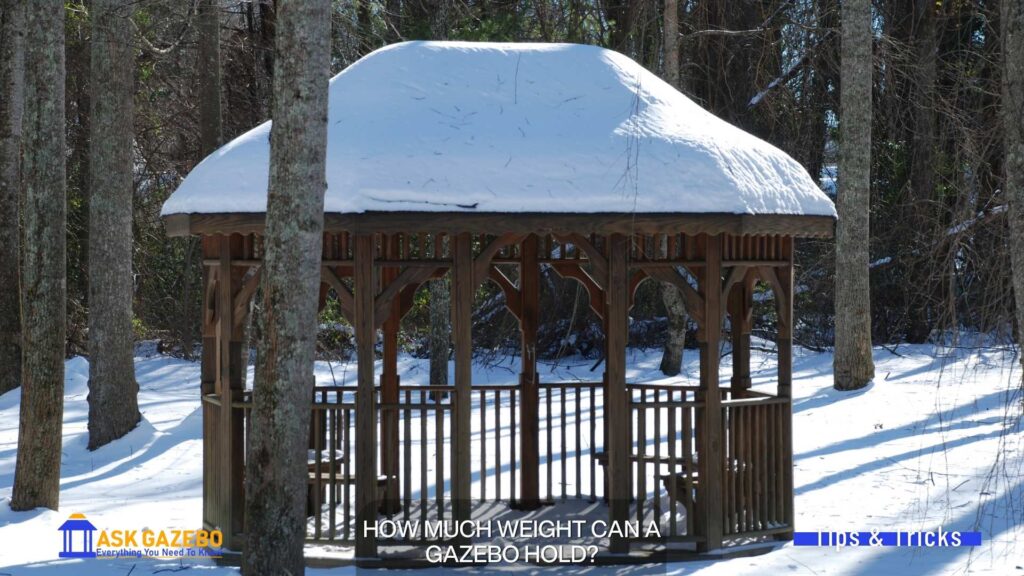If you know how much weight your gazebo can hold, you can avoid potential accidents and can use your outdoor gazebo safely and properly.
Understanding the weight limits of your gazebo is critical to getting the most out of this flexible and appealing building, whether you plan to use it for entertaining, or relaxing.
Weight capacity can vary from gazebo to gazebo. For example, this Arlington 12×12 All Cedar Gazebo is certified to hold 50 pounds per square foot or equivalent to 30 inches of snow.
In this post, we’ll look at the aspects that influence a gazebo’s weight capacity and offer advice on how to determine and maximize it.
What types of loads that a gazebo can hold?
Yes, gazebos are generally strong and can survive a wide range of situations, but knowing what types of loads they can support allows one to use and enjoy them securely while also preventing accidents or damage.
A gazebo can support three types of loads: dead loads, live loads, and environmental loads.
The weight of the gazebo itself, including the roof, walls, and flooring, is referred to as dead loads. These are constant loads that do not alter over time.
The weight of people, furniture, and other goods placed on or within the gazebo is referred to as a live load. These are dynamic loads that can change dramatically depending on how the gazebo is used.
The weight of wind, snow, and other external pressures that the gazebo may be subjected to is referred to as environmental loads. These loads can be especially difficult for a gazebo because they are frequently unpredictable and can alter quickly.
Wind and snow loads in the location where the gazebo will be located must be considered since these have a considerable impact on the gazebo’s weight capacity.
We have a dedicated guide on: How To Secure A Gazebo From Wind?
Factors that affect a gazebo’s weight capacity:
Several aspects can influence a gazebo’s ability to support these various types of loads. The weight capacity of a gazebo is determined by the size and shape of the gazebo, the materials used in construction, the kind of base, and the location and environment.
A larger gazebo, for example, with a stable foundation and strong, durable materials, will be able to support more weight than a smaller, poorly made gazebo.
A gazebo in a region with high winds or heavy snowfall needs to be constructed carefully to handle increased environmental demands.
When estimating the weight capacity of a gazebo, all of these elements must be taken into account. You can find out this information in the manufacturer’s specs or by speaking with a structural engineer or contractor.


How to determine a gazebo’s weight capacity?
Normally, a well-built gazebo can bear around 40 pounds per square foot of weight and a few high-end gazebos can bear around 110 pounds per square foot.
There are numerous methods for determining the weight capacity of a gazebo, and the most effective method will depend on the specific gazebo and the information provided.
Here are some procedures you can take to determine the weight capacity of a gazebo:
Check the manufacturer’s specifications:
Weight capacity information will be given in the manufacturer’s specifications or literature for every gazebo. This data could be in the form of a maximum weight capacity or a maximum live load rating.
It’s worth noting that these ratings are often based on ideal conditions, such as moderate temperatures and no wind or snow.
Consult with a structural engineer or contractor:
If the manufacturer’s requirements are unavailable or unclear, you may need to consult a structural engineer or a contractor. These experts can evaluate the materials, design, and foundation of the gazebo to establish its weight capability.
Contact with the manufacturer:
If you haven’t found any clear recommendation and couldn’t able to consult with an engineer, it is best to contact the manufacturer. They know their product better than anyone else. If you can contact them over a call, that would be great.
Test the gazebo’s weight capacity using safe methods:
In some circumstances, testing the gazebo’s weight capacity to determine its limits may be necessary. This can be accomplished by gradually and carefully putting weight on the gazebo and observing its reaction.
When checking the weight capacity, exercise caution because overloading the gazebo can cause it to break or collapse.
Checking the manufacturer’s specs and consulting with a structural expert or contractor are two useful techniques, and in some circumstances, testing the weight capacity of the gazebo using safe methods may be required.
Explore
Best Gazebo For High Winds in 2024
Discover the High-Quality, Durable, and Wind-Resistant Gazebos: Your Comprehensive Guide to the Best Gazebos for High Winds.
Safety Tips for Ensuring a Gazebo’s Structural Integrity:
Understanding and adhering to the weight restrictions of a gazebo is critical for avoiding accidents or damage.
Here are some safety tips to keep in mind:
Importance of respecting a gazebo’s weight limits:
To ensure that the building stays safe and stable, it is critical to understand and adhere to the weight restrictions of a gazebo. When a gazebo is overloaded, it might fail or collapse, resulting in significant injuries or property damage.
It is critical to evaluate carefully the types and amounts of goods that will be placed in or on the gazebo, as well as to distribute the weight as equally as possible.
Signs of a gazebo that is overloaded:
There are various signs when a gazebo is overloaded and at risk of failing.
Apparent sagging or bending of the roof or walls, creaking or groaning noises, and visible cracks or other damage are examples. If you see any of these symptoms, you must act quickly to minimize the weight on the gazebo.
Steps to take if a gazebo appears to be overloaded:
If a gazebo appears to be overloaded, it is critical to take action to lower the structure’s load.
It is also critical to thoroughly inspect the gazebo for any damage or weakness produced by the overload.
What to do if the Gazebo overload?
If a gazebo is overloaded, it is critical to act quickly to lessen the weight on the structure.
When a gazebo is overloaded, it might fail or collapse, resulting in significant injuries or property damage. If you feel that your gazebo is overloaded, follow these steps:
Remove items from the gazebo:
If the gazebo is full of heavy objects, eliminating some of them can assist alleviate the load on the structure. It is critical to proceed slowly and cautiously to prevent putting more strain on the gazebo.
It is also important to clear the snow from the roof of the gazebo if there is any. If there is Winter out there, you should clean the roof more often to keep your gazebo from being overloaded.
On the other hand, if you live in an area where high winds are common, try to lessen the impact of winds on your gazebo.
Related: How To Enclose a Gazebo For Winter
Redistribute the weight more evenly:
If the weight on the gazebo is not uniformly distributed, the structure may become unstable or fail. Moving items around carefully to distribute weight more equally can help lessen the chance of a collapse.
Seek the help of a structural engineer or a contractor:
If you are unsure how to lessen the load on the gazebo properly, or if you fear that the structure has been harmed by the overload, consult a structural expert or contractor. These experts can inspect the gazebo and make recommendations for reinforcing or strengthening the construction if necessary.
Assess the gazebo for damage:
After the gazebo’s load has been reduced, it is critical to thoroughly inspect the structure for any damage or weakness produced by the overload.
Inspecting the roof, walls, and foundation for visible indicators of damage, such as cracks, sagging, or bending, may be necessary. If you spot any damage, you should repair or reinforce the gazebo as needed to guarantee its stability and safety.
You might want to know How Far Should Gazebo Be From House.
FAQs
Will sandbags hold down a gazebo?
Sandbags can potentially be used to secure a gazebo in severe winds, but it is critical to use enough sandbags and lay them correctly to guarantee that the gazebo is adequately secured.
Additional means, like pegs or anchors, may be required to secure the gazebo to the ground.
Can gazebos withstand high winds?
The ability of a gazebo to endure severe winds is determined by a variety of factors, including the gazebo’s size and shape, the materials used in construction, the kind of base, and the wind conditions in the area.
Larger, sturdier gazebos with strong foundations and long-lasting materials are more likely to endure heavy winds than smaller, poorly built gazebos.
When choosing a gazebo, examine the wind conditions in the area and follow the correct installation and maintenance requirements to ensure its stability and safety.
Should I take sides off the gazebo in the wind?
In high wind conditions, it is advisable to remove the sides of a gazebo to reduce wind resistance and stress on the construction. However, before making this decision, it is critical to thoroughly analyze the wind conditions as well as the specific design and materials of the gazebo.
Removing a gazebo’s sides may not be appropriate in all circumstances, and it may be required to tether the gazebo to the ground or take other precautions to secure it in severe wind conditions.
Conclusion:
In conclusion, knowing how much weight a gazebo can support is critical for securely using and enjoying the structure. The materials used in construction, the size and design of the gazebo, the type of base, and the wind and weather conditions are all factors that can affect a gazebo’s weight capability.
Checking the manufacturer’s specs, talking with a structural expert or contractor, or testing the gazebo’s weight capacity using safe procedures can all be used to determine its weight capacity.
It is critical to adhere to the weight restrictions of a gazebo and be aware of the indicators of an overloaded gazebo, as overloading can cause the structure to fail or collapse.
By understanding a gazebo’s weight capacity and taking appropriate precautions, you can safely and effectively use and enjoy this versatile outdoor structure.









What if my manufacturer haven’t shared how much weight their gazebo can hold?
We highly suggest you contact the manufacturer. If it is not possible seek guidance from any contractor who can guide you regarding your specific gazebo. Alternatively, you can also carefully test the limit by adding some weight.